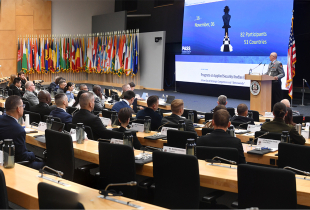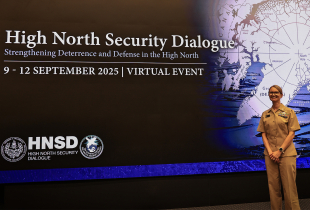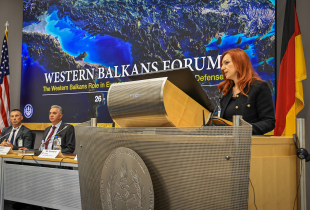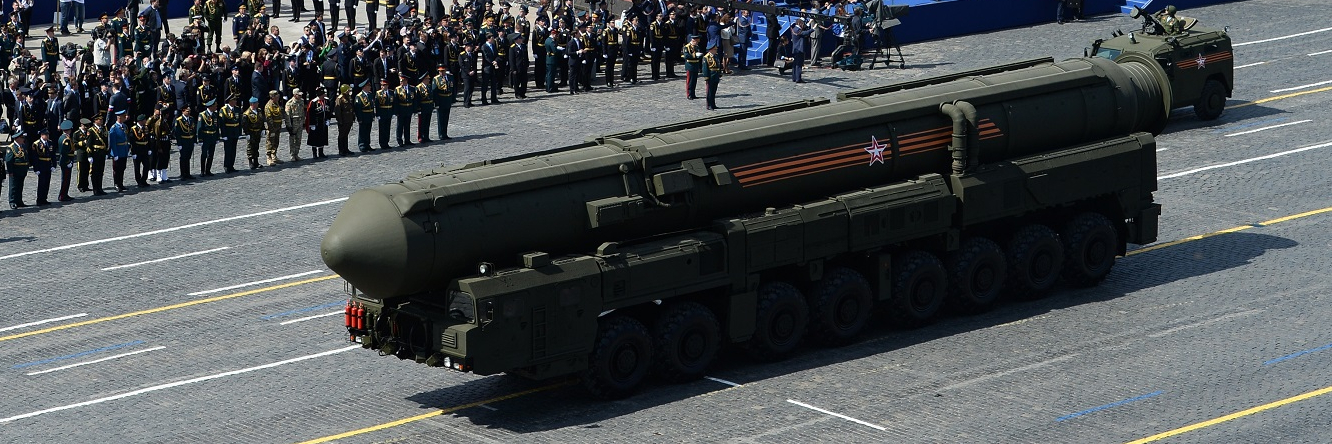
Chapter 11: Russian Nuclear Instruments and Arms Control Approaches
Introduction
Russia’s claims for a “Great Power” status and ambitions to emerge as a key power center in the presumed “multi-polar world” are not just underpinned but also shaped and driven by its possession of an arsenal of nuclear weapons, which quite probably is the largest in the world. Huge amounts of scarce resources are channeled into modernization of this arsenal, but Moscow finds it increasingly difficult to harvest political dividends from these investments. Upholding numerical parity with the United States, which has long been a fundamental principle of strategic stability, is unproblematic, but the high number of warheads does not translate into authority on the international arena or ability to influence global developments.1 In the new geopolitical configuration, shaped by the global consequences of the COVID-19 pandemic, Russia may find greater need to rely on its superior nuclear potential because other elements of its power, particularly the economy, are weakened and compromised; however, the applicability of nuclear instruments might diminish even further.
One of the most effective ways of capitalizing on the modern and diverse nuclear capabilities has traditionally been engagement in complicated arms control talks and agreements, first of all with the United States, which secured for the Soviet Union, and since the start of the 1990s – for Russia, the symbolic position of the second most powerful state in the world. This well-traveled avenue has, nevertheless, arrived to an apparent dead-end at the beginning of the 2020s. The breakdown of the Intermediate Nuclear Forces (INF) Treaty, signed by presidents Ronald Reagan and Mikhail Gorbachev in December 1987 and signifying the end of the Cold War, is the most apparent manifestation of the crisis in arms control, even if Russia is inclined to backdate the arrival of this crisis to the U.S. decision to withdraw from the Anti-Ballistic Missile (ABM) Treaty in December 2001.2
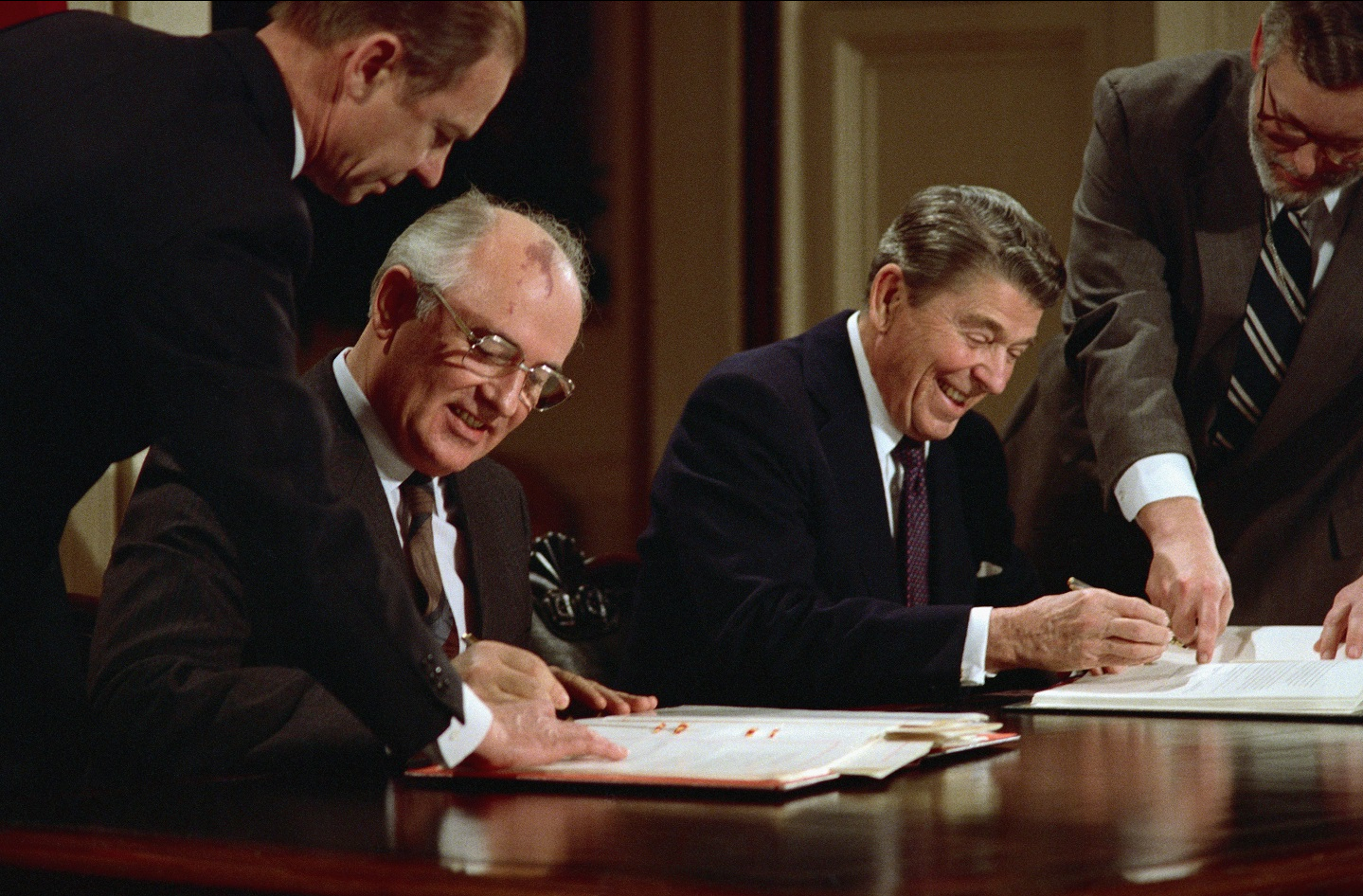
President Donald Trump’s announcement in May 2020 on U.S. withdrawal from the Treaty on Open Skies (though it doesn’t specifically concern nuclear matters) is another step along this track, and the expiration of the New Strategic Arms Reduction Treaty (New START) in February 2021 was set to bring this crisis to a logical conclusion.The extension of the New START by the Biden administration avoids an unlimited arms race and legally enshrines Russia’s position as equal partner of the United States, but it does not necessarily pave the way to new talks on strategic stability matters. Russia declares its strong dissatisfaction with this dismantlement of key structures of arms control and puts the blame squarely on the United States, denying its own systematic violations of many key provisions and ignoring the fact that its massive nuclear modernization programs have made the old agreements irrelevant and ineffectual. This posturing provides some justification for sustaining the priority investments in upgrading the nuclear arsenal, but it does not help with turning nuclear weapons into a useful and impactful instrument of policy, so Moscow will keep experimenting.
Achievements and Setbacks in Nuclear Modernization
It was at the start of the 2010s that Vladimir Putin – then prime minister and planning to reclaim the position of the president – set the course on modernization of Russia’s nuclear arsenal; this task was elevated to the top priority in the 2020 State Armament Program (SAP) approved in December 2010. What is remarkable, and in hindsight fallacious, about that plan was its ambition to upgrade all strategic capabilities and to develop a set of new non-strategic nuclear-capable weapon systems, which inevitably resulted in advancement on some directions and setbacks on others, making the structure of strategic nuclear forces seriously unbalanced. The 2027 SAP approved in December 2017, after a delay caused by the economic crisis of 2014-2017, acknowledged the imperative to cut down the scale of expenditures, but again prescribed modernization of the whole range of capabilities, failing to set meaningful priorities and to choose between building on the successes or addressing the failures.3
In the strategic triad, the naval section receives the bulk of funding, and the introduction of the new generation of Borei-class strategic submarines is the single most expensive project in both the 2020 and 2027 SAPs. The implementation was not without delays, caused primarily by failed tests of its main weapon system – the Bulava (SS-N-32) intercontinental missile – but in mid-2020, the fourth submarine of this class, K-548 Knyaz Vladimir, joined the Northern Fleet. The program progresses steadily, with four hulls in different stages of construction, and two more in planning, while the Borei-B modification was cancelled as it proved to be too expensive.4 Concentration of efforts on this project caused serious delays with the second high-priority project – the Yasen-class cruise missile nuclear submarines – so that only the pilot vessel (K-560 Severodvinsk) is commissioned, while the second sub (K-561 Kazan) is still undergoing trials, and five more hulls are under construction.5
Traditionally, the strongest (in the number of delivery vehicles) element of nuclear forces – the land-based intercontinental ballistic missiles – has progressed smoothly with the replacement of Topol (SS-25) missiles with the Topol-M (SS-27 Mod 1) and the Yars (SS-27 Mod 2) missiles, but the plan for deploying a new heavy liquid-fueled Sarmat (SS-X-30) missile has encountered unspecified technical issues, so by early-2021 not a single test has been performed. Lacking Sarmat, the newly-developed hypersonic glide vehicle, Avangard is combined with the SS-19 missile, which should have been retired by 2020.6 Long-range aviation is the most useful type of strategic weapon for demonstrations of power, but the production base has crumbled, so the proposition for developing a new generation PAK DA bomber is postponed into indefinite mid-term.7 The plan for resuming serial production of the Tu-160 bomber has also run into trouble, so Russia has to rely on the legacy Tu-95 and Tu-22M3 airframes, which are prone to technical failures.8
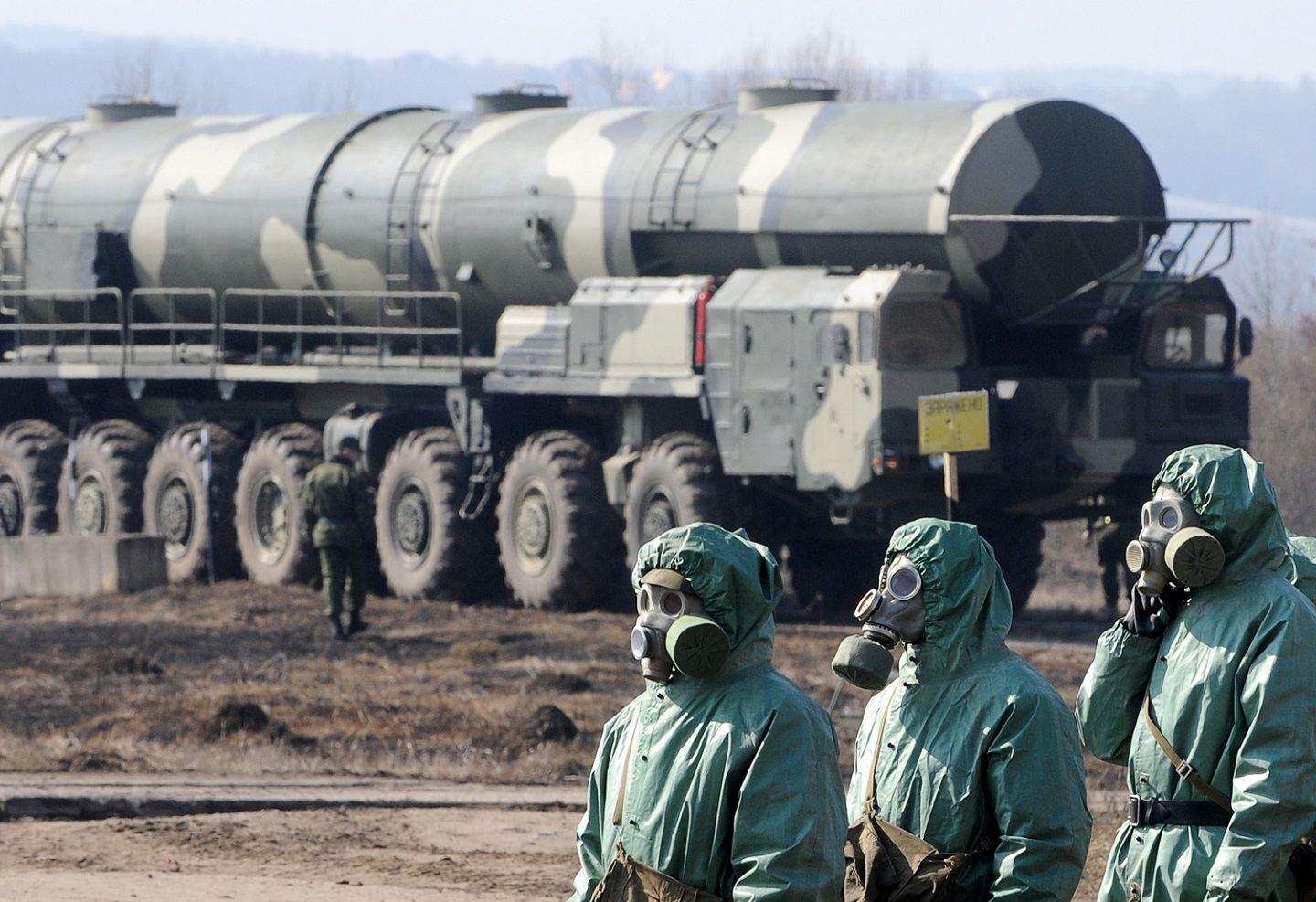
Significant success has been achieved in developing a remarkable variety of air-launched and ship/submarine-launched nuclear-capable missiles, as well as surface-to-air missile systems with anti-missile and anti-satellite characteristics. The long-range Kalibr (SS-N-27) cruise missile was tested in combat operations in Syria and is now fitted on various naval platforms, including low-displacement corvettes, as key means of projecting firepower on-shore. The hypersonic air-launched ballistic missile Kinzhal is entering service with the MiG-31K fighter as a key platform, though the strategic rationale for this unconventional design is dubious.9 The anti-ship hypersonic cruise missile Tsirkon (SS-N-33) is yet to complete its program of tests, but potentially, this application of hypersonic technologies could constitute a game changer in modern naval warfare.10
As impressive as these high-tech weapon systems appear to be, they require corresponding upgrades in command and control systems, real-time intelligence gathering, target acquisition, etc., and the Russian armed forces cannot hope to meet many of these requirements. One particular weakness is the insufficient capacity of satellite communications and monitoring, which may increase further due to the mounting problems in the Russian space program.11 The strategic early warning system, for that matter, relies more on the modern phased-array Voronezh-M/DM/VP radars, seven of which have become operational since 2012 and two more are under construction (including one in Crimea), than on the reduced grouping of satellites. Another essential consideration is that in order to make non-strategic nuclear-capable weapon systems into useful instruments of nuclear policy, they need to be connected with nuclear warheads but there are few signs of such interoperability. The openly available data on non-strategic nuclear munitions is no better than anecdotal, but it can be established for fact that they are safely locked in the central storage facilities.12
Perhaps the most serious risk related to the execution of nuclear modernization plans concern the high probability of accidents. At least three such setbacks happened in 2019, one involving a case of a deadly shooting, allegedly caused by bullying (dedovshchina), in the military unit servicing nuclear munitions.13 A fire on board the nuclear-powered submersible AS-31 (nicknamed Losharik), resulted in an explosion claiming the lives of fourteen officers, but a greater disaster was averted by the closure of its connection with the transport vessel – nuclear submarine Podmoskovye (converted Delta IV-class).14 It took great effort by investigative journalists to breach the wall of secrecy around the explosion of a nuclear-propelled missile after a failed test near Severodvinsk, Arkhangelsk region, with seven lives lost and a widespread panic about radioactive contamination.15 President Putin asserted that tests would continue “no matter what,” but in fact no new advances in this program have been reported.16
Russia’s efforts at modernizing its nuclear capabilities have involved remarkably wide range of projects, which follows the Soviet pattern of developing and deploying multiple weapon systems of similar kind and putting the interests of defense-industrial complex ahead of requests from the military. This desire to get ahead of competitors on every direction in the arms race is incompatible with Russia’s deteriorating industrial base, and in the situation of a severe economic recession, painful choices on cutting funding for newly-launched and half-implemented programs will result in debilitating disruptions and conflicts.
Opportunities and Limitations in Wielding Nuclear Instruments
The scale of effort directed into upgrading and diversifying the nuclear arsenal implies the desire in the Russian leadership to use it for achieving more ambitious goals than merely deterrence, which could be secured with much more modest means. What has constituted a tricky problem for Moscow is the parallel desire to uphold the system of international norms and regulations, which grants it tangible privileges, such as the permanent seat at the UN Security Council table. This political proposition of having it both ways – making nuclear weapons into more applicable instruments of policy and presenting itself as an adherent of the arms control system – became clear in Putin’s 2018 address to the Federal Assembly, more than half of which was rather unexpectedly devoted to nuclear rearmament.17 The animated presentation of a set on new weapon systems impressed not only his excitable audience but also Western policy-planners, and Putin sought to reinforce the impact by adding new emphasis in the 2019 address.18 He did not return to this theme, however, in the 2020 address, focusing instead on his domestic agenda, and this may reflect the recognition that the course of travelling along two diverging tracks has arrived at dead-ends on both.
Key targets for Putin’s virtual application of “wonder-missiles” were European NATO member-states, where anti-nuclear feelings are reinvigorated with the campaign to promote the Treaty on the Prohibition of Nuclear Weapons (TPNW, 2017).19 The clear intent was to deepen and exploit the split between the U.S. and its European allies, much the same way as with the previous efforts to block and compromise the NATO commitment to building the European missile defense system. At present, those efforts are largely abandoned as Russia deploys the S-400 surface-to-air missile systems from Syria to Kaliningrad and tests several advanced anti-missile weapons from the A-235 Nudol interceptor to the S-500 Prometheus.20 The new push also failed to convert nuclear fears into opposition to U.S. policies, and NATO was able to make a firm collective stance on holding Russia responsible for violating the INF Treaty and on justifying the U.S. withdrawal.21 Putin’s bragging about new missiles has made it apparent that the framework of the INF Treaty became irrelevant for monitoring the arms race and convinced key European states to rethink the parameters of deterrence and the scope of their defense efforts.22 Even the states that initiated and promoted the work on the TPNW, such as Norway and Sweden, have opted not to join it because the nuclear threat from Russia is seen as compelling new investments in containment.
Another key aim of Russia’s nuclear build-up is to deter the threat of revolutions, which might appear to stretch the borders of common strategic sense, particularly since it marks a radical departure from the Leninist doctrine of revolutions, which focuses on internal political crises maturing into revolutionary situations. Current obsession in the Kremlin with exorcising the specter of “color revolutions” is caused by the inherent instability of Putin’s autocratic regime, with its spectacular corruption and hostility to reforms, and it is the preoccupation with the perceived Western sponsorship and manipulation of protests that underpins the idea of deterring this interference with nuclear instruments.23 In Russian strategic thinking, “color revolutions” are now defined as a new form of warfare, in which Western incitement of unrest is combined with U.S. high-precision strikes, so that Russia’s possession of a versatile arsenal of nuclear weapons makes the former too risky and the latter – not only rendered ineffectual by missile defense system but also punishable by retaliatory strikes.24
The risks are rather too obvious, not least because of the accidents, which are presented as heroic encounters with unpredictable dangers, but the credibility of the implicit rather than openly declared threat of resorting to nuclear strikes needs to be constantly re-established. Russian high command has resolutely denied that any strategic proposition resembling the much-debated “escalate to de-escalate” concept ever existed, and Putin in his capacity as the commander-in-chief has ruled out planning for a first nuclear strike, while making plenty of vague pronouncements about a nuclear catastrophe.25 In-depth research into new features in Russian strategic thinking and their manifestations in military preparations and training reveals, nevertheless, that a nuclear strike in the course of conventional war aimed at securing a victory (or at least an agreeable outcome) for Russia is perceived as a feasible and justifiable option.26 The question about whether the Kremlin might resort to such option not only in bello but also in the course of a domestic unrest threatening to dislodge the ruling regime (and perceived as a hostile action directed from abroad) does not amount to an exercise in thinking about the unthinkable.27 Persistent recycling by the Russian elites of the mind-boggling thesis “Нет Путина – Нет России” (If there is no Putin – there is no Russia) indicates that this question cannot be answered in the negative.28
This strategic messaging – loaded with heavy hints – is aimed not only at Western adversaries but also at China, which is a crucially important “strategic partner” for Russia, and certainly a very difficult one. Some mainstream analysis in Moscow argue that the steady upgrading of security ties since mid-2014 amounts to emergence of a military alliance, even if formally undeclared, while others keep reminding about security threats emanating from the rising power in Russia’s far neighborhood.29 For the Kremlin, the obvious power inequality in the highly-valued partnership and Russia’s deepening dependency upon the economic ties with China constitute a source of grave concern, and greater political reliance on its strategic nuclear arsenal, which is far superior to China’s capabilities, makes it possible to alleviate those. For that matter, the one-off joint patrol by two Russian and two Chinese strategic bombers over the Sea of Japan in July 2019, had little real significance (yet caused a serious military incident involving South Korea) and was intended as a demonstration of the greater reach of Russian long-range aviation when compared to Chinese capabilities.30
Putin’s announcement (which remains unsubstantiated) that Russia is providing support to China in building a modern early warning system is much more a sign of intentions to bring this superiority into the context of mutual geo-strategic posturing than a real step in upgrading strategic ties.31 What the Kremlin cannot possibly deliver is a Chinese engagement in, not to say commitment to, arms control negotiations in a new tri-lateral setting, on which the Trump administration firmly insisted, and it appears possible to assume that this insistence will only increase in the coming years, as the Biden administration charts a steady course of countering China’s rising aggressiveness.32 There is scant information in Moscow on the guidelines and parameters of the Chinese nuclear modernization program – but a fairly clear understanding that Beijing is not interested in adjusting these guidelines according to any newly-agreed ceilings or exposing these parameters to external monitoring. There is also a clear impression that China would much prefer to see Russia go an extra diplomatic mile toward preserving the remaining structures of arms control and avoid blatant violations of old commitments.
The region where Russian nuclear build-up produces the heaviest security implications – and where China gradually advances its interests – is in the Arctic. The Kola Peninsula, with its extraordinary concentration of nuclear submarines, warheads, and waste, is by far the most nuclearized area in the world, and Russian high command executes a complex program of military build-up aimed at protecting these assets.33 This sustained militarization undercuts efforts at promoting international cooperation in the High North (as described in Chapter 4) and interferes with Chinese interests in the Arctic, focused on economic and commercial expansion, which defines the security perspective.34 Russia’s Nordic neighbors are greatly concerned about the nuclear risks, but China is also perfectly aware that the tests of nuclear-propelled cruise missiles and underwater drones advertised by President Putin can only be performed in Northern test sites – and involve high probability of radioactive contamination.35 Many policy analyses tend to mix together Russian and Chinese ambitions and military preparations in the High North.36 In fact, however, China explicitly disapproves of the militarization of the Arctic and constitutes to all intents and purposes the most significant influence which persuades Russia to move with extra care when implementing its nuclear plans in the region.
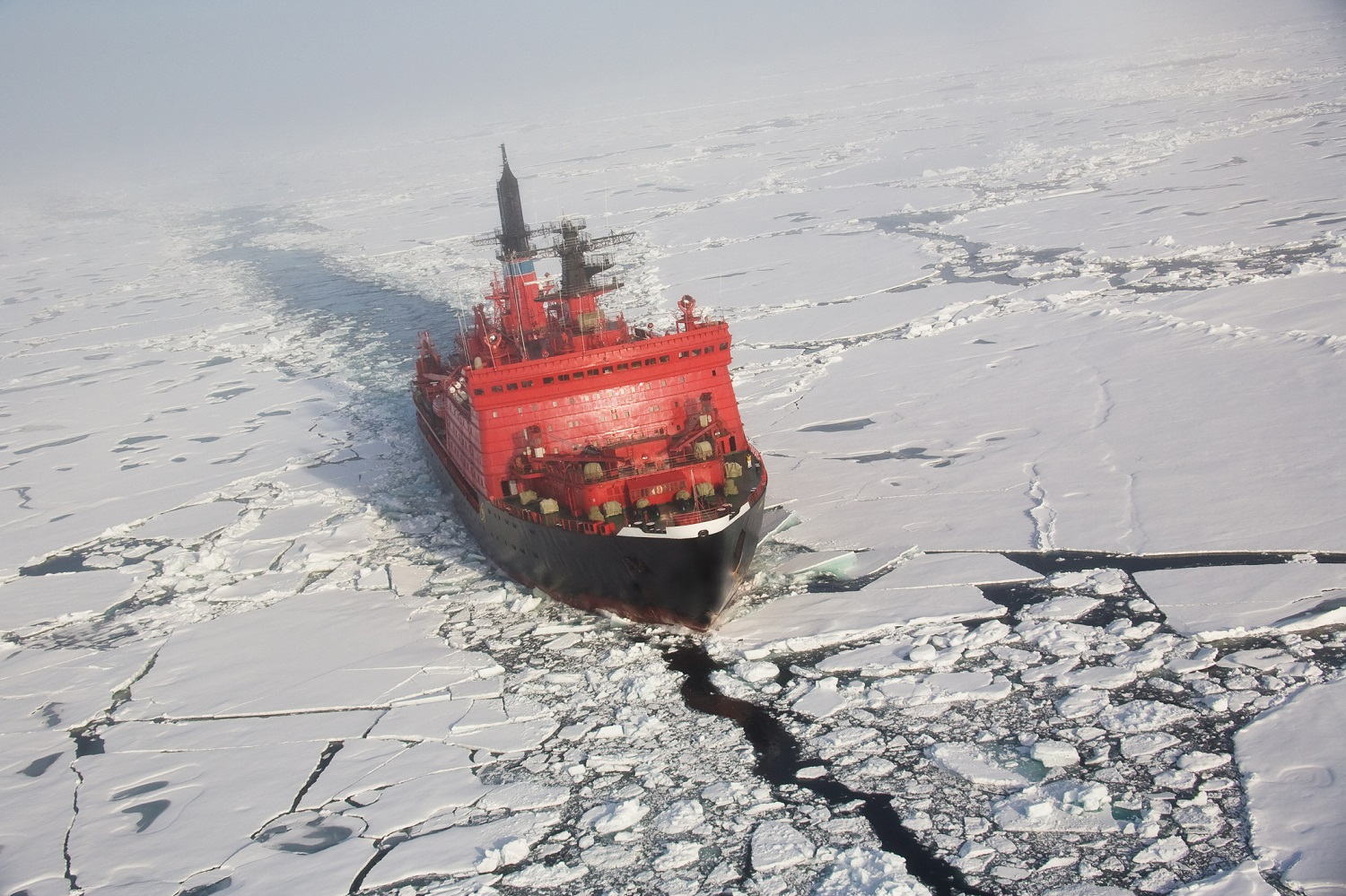
Overall, Moscow’s track record in using nuclear weapons as instruments of policy is mixed at best, and the breakdown of the key structures of arms control – caused in a large measure by these experiments in wielding nuclear instruments – is a serious setback for the policy of upholding Russia’s international status. In the situation of fast-shifting global geopolitical interactions and Russia’s eroding economic strength and political stability, its anxious autocratic regime may see greater need in relying upon its upgraded but under-utilized nuclear assets.
Prospects and Implications
Russia has every reason to suspect that the impact of the COVID-19 pandemic would be seriously detrimental to its global positions and prestige. The whole scope of this impact cannot presently be judged even approximately, but it stands to reason to expect that international status of major powers would be determined by their economic resurgence, dynamism, capacity for innovations, and efficiency of health care systems – and not by the size of their nuclear arsenals. In all these components of state strength, Russia was lagging before the coronavirus outbreak and is set to fall further behind due to its mismanagement. Seeking to regain domestic support, Putin’s elites need to return nuclear problems to the center of global affairs, but they are aware that the U.S. under the Biden administration would aim at de-escalating and de-prioritizing these problems.
The decree on the Fundamentals of Russia’s Nuclear Deterrence State Policy (a first ever document of its kind) signed by President Putin on June 2, 2020, signifies a step in uplifting nuclear matters.37 The swift extension of the New START intended by the Biden team as means to solve and close a major problem, can provide for Moscow a convenient moment for launching a new pro-active nuclear maneuvering, beyond the specific area covered by the treaty, which is seen by Russian experts as relatively stable.38 The easiest moves could be the transfer of non-strategic nuclear munitions to storage in newly-secured “fortresses” of Crimea and Kaliningrad, which have so far remained nuclear weapons-free, while deploying such delivery systems as Iskander-M mobile ballistic/cruise missile launchers. After assessing European reactions, Moscow can follow-up with the cancellation of the Presidential Nuclear Initiative (PNI) – a unilateral decision on keeping all non-strategic nuclear warheads in central storage made in 1991 by President Mikhail Gorbachev in response to the similar decision by U.S. President George H.W. Bush.39 The U.S. government may not have plans for altering the arrangement for non-deployment of such munitions, but it might find it impossible to sustain the unverifiable trust-based PNI deal.
Russia may seek opportunities to re-focus attention to nuclear matters in the run-up to the NPT Review Conference, which was postponed from 2020 to 2021 because of the COVID-19 pandemic.40 This delay grants Moscow extra space for exploring and exploiting disagreements in the non-proliferation movement caused in a large measure by its own massive nuclear modernization program, which clearly contradicts the commitment to progressing to full nuclear disarmament made in the NPT. So far, Russia has not found useful opportunities to engage with two of the most urgent problems in the non-proliferation domain: the development of nuclear weapons by North Korea and the U.S.-initiated breakdown of the 2015 international deal (known as the Joint Comprehensive Plan of Action, JCPOA) on the Iranian nuclear program. Regarding the former, Moscow defers to China’s leadership in managing the crisis (even if it resents being cut out of the China-U.S. deliberations), but Putin ventures persistently an opinion that North Korea would never give up its nuclear capabilities.41 As for the latter, Moscow is reluctant to openly support Iranian resumption of the uranium enrichment projects, seeking to avoid damage to its already complicated relations with Saudi Arabia, as well as Israel. Its formal support for restoring the JCPOA is underpinned by the assumption that the Biden administration would aim at revising it, but in probable new multilateral talks, it might take a less constructive position than it did in 2013-2015.42 Portraying itself as a staunch supporter of the non-proliferation regime, Russia in fact stands to benefit from its erosion, since the size of its nuclear arsenal would grant it superiority over any newly-nuclearized state, while relevance of this instrument would increase.
Moscow might also take steps toward withdrawing from the Comprehensive Nuclear Test Ban Treaty (CNTB), which it signed in September 1996 and ratified in June 2000, citing U.S. failure to ratify it (after signing in September 1996) and preparations for conducting a test.43 In fact, Russia itself has been preparing the Novaya Zemlya test site for more serious experiments than subcritical of very low-yield tests.44 This would generate hard pressure on European NATO member-states, particularly Norway, while the associated risks would be in the opinion of Russian high commend, entirely acceptable and even lower than those produced by testing of nuclear-propelled missiles.
Russia will eagerly engage in new talks on strategic stability with the United States, presenting them as a recognition of its unique global status, but it will try to load the agenda with so many arduous issues (like missile defense or de-militarization of space activities) that a protracted deadlock is guaranteed, while its own projects (for instance, on anti-satellite weapons) would proceed unhampered. This bilateral nuclear diplomacy will also aim at aggravating concerns among the Europeans and compromising the intention of rehabilitating the trans-Atlantic solidarity proclaimed by President Biden. The only real limitation for Russian nuclear modernization will be the shortage of resources aggravated by economic recession, and Moscow is unlikely to find a way out.
For Academic Citation
Pavel K. Baev, “Russian Nuclear Instruments and Arms Control Approaches,” in Russia’s Global Reach: A Security and Statecraft Assessment, ed. Graeme P. Herd (Garmisch-Partenkirchen: George C. Marshall European Center for Security Studies, 2021), https://www.marshallcenter.org/en/publications/marshall-center-books/russias-global-reach/chapter-11-russian-nuclear-instruments-and-arms-control-approaches, 91-100.
Notes
1 Strategic weapon systems are reasonably accounted for in the long-established patterns of data exchange and verification, but the stockpile of non-strategic nuclear warheads have always been covered by secrecy, so the current estimates giving Russia the total number of 6,500 and the United States – 6,185, cannot be reliably confirmed. See for instance, Shannon N. Kile and Hans M. Kristensen, “World Nuclear Forces,” in SIPRI Yearbook 2019 (Oxford: OUP, 2019).
2 One balanced and knowledgeable presentation of Russian perspectives is Alexei Arbatov, “A New Era of Arms Control: Myths, Realities and Options,” Carnegie Moscow Center Report, October 24, 2019, https://carnegie.ru/commentary/80172.
3 A sound analysis of the 2027 SAP guidelines is Richard Connoly and Mathieu Boulegue, “Russia’s New State Armament Programme,” RIIA Research Paper, (London: Chatham House, May 2018), https://www.chathamhouse.org/publication/russia-s-new-state-armament-programme-implications-russian-armed-forces-and-military. For an in-depth assessment of nuclear programs, see Julian Cooper, “The funding of nuclear weapons in the Russian Federation,” Changing Character of War Centre Report, October 2018, http://www.ccw.ox.ac.uk/blog/2018/10/1/the-funding-of-nuclear-weapons-in-the-russian-federation-by-julian-cooper.
4 Martin Manaranche, “Russian Navy likely to have 12 Borei-class SSBN,” Naval News, April 27, 2020, https://www.navalnews.com/naval-news/2020/04/russian-navy-likely-to-have-12-borei-class-ssbn-part-1/.
5 Robert Beckhusen, “Russia’s Navy is having a submarine problem,” National Interest, January 22, 2020, https://nationalinterest.org/blog/buzz/russias-navy-having-submarine-problem-and-there-no-easy-solution-115886).
6 Michael Kofman, “Beyond the hype of Russia’s hypersonic weapons,” The Moscow Times, January 16, 2020, https://www.themoscowtimes.com/2020/01/15/russias-hypersonic-weapons-a68907.
7 One optimistic Russian description is Anton Lavrov, Roman Kretsul, and Alexei Ramm, “The PAK-agreement: Newest bomber is scheduled for serial production,” Izvestiya (in Russian), January 14, 2020, https://iz.ru/963694/anton-lavrov-roman-kretcul-aleksei-ramm/paketnoe-soglashenie-noveishemu-bombardirovshchiku-naznachili-sroki-vykhoda-v-seriiu.
8 Detailed analysis can be found in Mark B. Schneider, “Russia’s modernization programs for strategic nuclear bombers,” RealClearDefense, March 24, 2020, https://www.realcleardefense.com/articles/2020/03/24/russias modernization programs for strategic nuclear bombers 115141.html.
9 Roger McDermott, “Russia’s Airspace forces prepare training for Kinzhal hypersonic missiles,” Eurasia Daily Monitor, May 13, 2020, https://jamestown.org/program/russias-aerospace-forces-prepare-training-for-kinzhal-hypersonic-missiles/.
10 A useful overview of hypersonic missile developments is Kelley M. Sayler, “Hypersonic Weapons: Background and Issues for Congress,” CRS Report, March 17, 2020, https://fas.org/sgp/crs/weapons/R45811.pdf.
11 Informed and updated evaluation of these problems can be found in Pavel Luzin, “Price and prospects of the military space program,” Riddle, May 22, 2020, https://www.ridl.io/en/price-and-prospects-of-the-military-space-programme/.
12 Detailed examination of these facilities can be found in Pavel Podvig and Javier Serrat, “Lock them up: Zero-deployed non-strategic nuclear weapons in Europe,” UNIDIR Resources, 2017, http://www.unidir.org/files/publications/pdfs/lock-them-up-zero-deployed-non-strategic-nuclear-weapons-in-europe-en-675.pdf.
13 Irek Murtazin, “He finished them with single shots,” Novaya gazeta (in Russian), October 26, 2019, https://novayagazeta.ru/articles/2019/10/26/82511-i-dobival-odinochnymi-vystrelami.
14 Initial reports described the damage as insignificant, but later it became clear that the AS-31, the only submarine of its type, was damaged beyond repair; see Pavel Baev, “Another Russian sea tragedy: unlearned lessons obscured by secrecy,” Eurasia Daily Monitor, July 8, 2019, https://jamestown.org/program/another-russian-sea-tragedy-unlearned-lessons-obscured-by-secrecy/.
15 Crucial information was uncovered in Sergei Dobrynin and Mark Krutov, “The water column raised to about 100 meters,” Radio Liberty (in Russian), August 29, 2019, https://www.svoboda.org/a/30135210.html.
16 On Putin’s ambivalent stance regarding this tragedy, see Alexander Golts, “In the race for super-weapons,” Republic.ru (in Russian), November 26, 2019, https://republic.ru/posts/95309.
17 My detailed examination of the guidelines set in that address are in Pavel K. Baev, “Russian nuclear modernization and Putin’s wonder-missiles: real issues and false posturing,” Russie.Nei.Visions Report 115, IFRI: Paris, August 2019, https://www.ifri.org/en/publications/notes-de-lifri/russieneivisions/russian-nuclear-modernization-and-putins-wonder.
18 Pavel Felgengauer, “Putin promises Russians prosperity while challenging the West with nuclear super-weapons,” Eurasia Daily Monitor, February 21, 2019, https://jamestown.org/program/putin-promises-russians-prosperity-while-challenging-the-west-with-nuclear-superweapons/.
19 A good overview can be found in Daryl Kimball, “The Treaty on the Prohibition of Nuclear Weapons at a glance,” Fact Sheets and Briefs, Arms Control Association, March 2020, (https://www.armscontrol.org/factsheets/nuclearprohibition).
20 On the latter, see Mark Episkopos, “How worried should the Air Force be about Russia’s S-500 missile defense system?” National Interest, March 2, 2020, https://nationalinterest.org/blog/buzz/how-worried-should-air-force-be-about-russias-s-500-missile-defense-system-128927.
21 This stance is elaborated in Rose Gottemoeller, NATO Deputy Secretary General, presentation at the University of Oslo; see “NATO nuclear policy in post-INF world,” NATO Newsroom, September 10, 2019, https://www.nato.int/cps/en/natohq/opinions_168602.htm.
22 Manuel Lafont Rapnouil, Tara Varma, and Nick Witney, “Eyes tight shut: European attitudes towards nuclear deterrence,” ECFR Report, December 2018, https://www.ecfr.eu/specials/scorecard/eyes_tight_shut_european_attitudes_towards_nuclear_deterrence.
23 My research on this counter-revolutionary policy can be found in Pavel K. Baev, “Revisiting the problem of post-Soviet revolutions,” International Relations and Diplomacy 7, no. 8 (August 2019): 363-369.
24 In-depth analysis on the shifts in Russian strategic thinking is presented in Oscar Jonsson, The Russian Understanding of War: Blurring Lines Between War and Peace (Washington, DC: Georgetown University Press, 2019). On the imaginary U.S. “Trojan horse” strategy, see Roger McDermott, “Gerasimov unveils Russia’s ‘strategy of limited actions,’” Eurasia Daily Monitor, March 6, 2019, https://jamestown.org/program/gerasimov-unveils-russias-strategy-of-limited-actions/.
25 One useful evaluation of this discourse is Kevin Ryan, “Is ‘Escalate to De-Escalate’ Part of Russia’s Nuclear Toolbox?” Russia Matters, Belfer Center, Harvard Kennedy School, January 8, 2020, https://www.russiamatters.org/analysis/escalate-deescalate-part-russias-nuclear-toolbox.
26 Perhaps the best openly available research of this kind is Michael Kofman, Anya Fink, and Jeffrey Edmonds, “Russian Strategy for Escalation Management: Evolution of Key Concepts,” CNA Report, April 2020, https://russianmilitaryanalysis.files.wordpress.com/2020/04/russian-strategy-for-escalation-management-main-concepts.pdf.
27 One sober evaluation is Olga Oliker, “Moscow’s Nuclear Enigma: What Is Russia’s Arsenal Really For?” Foreign Affairs, November/December (2018), https://www.foreignaffairs.com/articles/russian-federation/2018-10-15/moscows-nuclear-enigma.
28 A sharp recent take on this thesis is Sergei Guriev, “Putin’s senseless coup,” Vedomosti (in Russian), January 21, 2020, https://www.vedomosti.ru/opinion/articles/2020/01/21/821172-perevorot-putina.
29 For the former point of view, see Vassily Kashin, “Tacit Alliance: Russia and China Take Military Partnership to a New Level,” Commentary, Carnegie Moscow Center, October 22, 2019, https://carnegie.ru/commentary/80136. For the latter, see Aleksandr Khramchihin, “Why it is necessary to secure Russia’s eastern borders,” Nezavisimoe voennoe obozrenie (in Russian), February 9, 2018, http://nvo.ng.ru/concepts/2018-02-09/1_983_why.html.
30 Michael Kofman, “Russia-China bomber patrol shows stronger alignment between the two,” Russia Matters, Harvard Kennedy School, July 26, 2019, https://www.russiamatters.org/analysis/russia-china-bomber-patrol-shows-stronger-alignment-between-two.
31 An example of over-estimation of this step is Stephen Blank, “China and Russia: A Burgeoning Alliance,” US Naval Institute Proceedings, March 2020, https://www.usni.org/magazines/proceedings/2020/march/china-and-russia-burgeoning-alliance.
32 One insightful perspective is Steven Pifer, “Russia’s shifting views of multilateral arms control with China,” Order from Chaos, Brookings Institution, February 19, 2020, https://www.brookings.edu/blog/order-from-chaos/2020/02/19/russias-shifting-views-of-multilateral-nuclear-arms-control-with-china/.
33 A balanced assessment can be found in Mathieu Boulegue, “Russia’s Military Posture in the Arctic,” Chatham House Research Paper, June 2019, https://www.chathamhouse.org/2019/06/russias-military-posture-arctic.
34 One useful analysis is Heljar Havnes and Johan M. Seland, “The increasing security focus in China’s Arctic policy,” The Arctic Institute Article, July 16, 2019, https://www.thearcticinstitute.org/increasing-security-focus-china-arctic-policy/.
35 Dave Makichuk, “Russia to test ‘Doomsday Drone’ in the high Arctic,” Asia Times, May 26, 2020, https://asiatimes.com/2020/05/russia-set-to-test-doomsday-drone-in-high-arctic/.
36 “US warns of Russian Arctic military build-up,” High North News, May 25, 2020 https://www.highnorthnews.com/en/us-warns-russian-arctic-military-buildup-who-puts-missiles-icebreakers.
37 The text of the document is available at the Kremlin website, http://kremlin.ru/acts/news/63447.
38 Andrey Baklitsky, Evgeny Buzhinsky, Vladimir Orlov, and Sergey Semyonov, “If the New START Treaty expires with no extension: Scenarios for Russia,” PIR Center Policy Memo, May 26, 2020, http://www.pircenter.
org/en/articles/2218-3795646.
39 In depth research on that episode is Susan J. Koch, “The Presidential Nuclear Initiatives of 1991-1992,” Case Study 5, Center for the Study of Weapons of Mass Destruction, NDU, September 2012, https://ndupress.ndu.edu/Portals/68/Documents/casestudies/CSWMD_CaseStudy-5.pdf.
40 The argument for postponing the event further is presented in Tariq Rauf, “The postponed 2020 NPT Review Conference: A modest proposal,” Bulletin of Atomic Scientists, June 2, 2020, https://thebulletin.org/2020/06/the-postponed-2020-npt-review-conference-a-modest-proposal/.
41 An insightful view is Andrei Lankov, “The fourth in the queue: Why Kim needs the meeting with Putin,” Commentary (in Russian), Carnegie Moscow Center, April 26, 2019, https://carnegie.ru/commentary/79007.
42 One sign of this change is noted in Michael Lipin, “Russia upsets efforts to save 2015 Iran nuclear deal,” Voice of America, December 6, 2019, https://www.voanews.com/middle-east/voa-news-iran/russia-upsets-effort-save-2015-iran-nuclear-deal.
43 David Axe, “Donald Trump’s nuke-testing idea is ‘Catastrophically Stupid,’” Forbes, May 29, 2020, https://www.forbes.com/sites/davidaxe/2020/05/29/donald-trumps-nuke-testing-idea-is-catastrophically-stupid/#62cbbaae5c11.
44 Mark B. Schneider, “Yes, the Russians are testing nuclear weapons and it is very important,” Real Clear Defense, August 8, 2019, https://www.realcleardefense.com/articles/2019/08/08/yes the russians are testing nuclear weapons and it is very important_114651.html.
About the Author
Dr. Pavel Baev is a Research Professor at the Peace Research Institute Oslo (PRIO). He is also a Senior Non-Resident Scholar at the Brookings Institutions (Washington, DC) and a Senior Research Associate with the French International Affairs Institute (IFRI, Paris). Pavel specializes in Russian military reform; Russian conflict management in the Caucasus and Central Asia; energy interests in Russia’s foreign policy; and Russian relations with Europe and NATO.
The George C. Marshall European Center for Security Studies
The George C. Marshall European Center for Security Studies in Garmisch-Partenkirchen, Germany, a German-American partnership, is committed to creating and enhancing worldwide networks to address global and regional security challenges. The Marshall Center offers fifteen resident programs designed to promote peaceful, whole of government approaches to address today’s most pressing security challenges. Since its creation in 1992, the Marshall Center’s alumni network has grown to include over 14,400 professionals from 156 countries. More information on the Marshall Center can be found online at www.marshallcenter.org.
The views expressed in this publication are those of the author(s) and do not necessarily reflect the official policy or position of the George C. Marshall European Center for Security Studies, the U.S. Department of Defense, the German Ministry of Defense, or the United States, German, or any other governments. This report is approved for public release; distribution is unlimited.
